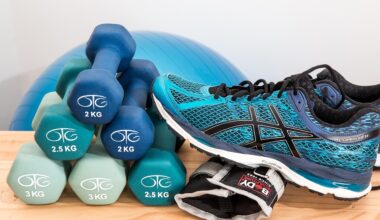Youth High Jump: Transitioning from Training to Competition
High jump, a fascinating and dynamic athletics event, requires solid training and mental preparation. As young athletes engage in high jump, transitioning from practice to competition presents unique challenges. Athletes must master the technique, balance, and timing essential for success. Understanding the mechanics of the high jump is vital, as it often determines whether an athlete surpasses their personal best. Coaches should emphasize proper takeoff, bar clearance, and landing techniques to build confidence. Ensuring that athletes stay engaged during this crucial phase will instill a competitive mindset. Practicing under competitive conditions can help gear up for real meets. Additionally, athletes should familiarize themselves with the competition format, including warm-up routines, field rules, and equipment checks. It is also essential for young high jumpers to maintain a balanced training schedule, allowing time for rest and recovery. Proper nutrition and hydration in preparation for the competitive season cannot be overstated. Staying injury-free while enhancing performance requires dedication to both physical and mental aspects of the sport. Ultimately, transitioning into competition is an exciting journey for youth athletes as they pursue personal records and sportsmanship.
Key Skills for Youth High Jumpers
In youth high jump training, mastering key skills can be the difference between winning and being just another competitor. Athletes must first acquire a sound technique, starting from the approach run through to the jump itself. Developing speed during the approach is vital, as it contributes to jumping height. Athletes should practice honing their stride pattern, ensuring consistency and optimal power. The takeoff is another critical skill that involves converting forward momentum into upward ascent. Here, strength training becomes essential, as it builds the explosive power necessary for an effective takeoff. Simultaneously, body positioning in the air should follow a clear strategy to maximize height. Additionally, mental resilience plays a significant role in the success of high jumpers. Have them visualize their jumps, aiming to create a positive mental image before each attempt. Encouragement from coaches and teammates contributes to their mental fortitude. Athletes should learn to manage pressure leading to competitions, embracing the fear of failure. This ability to perform under pressure is what separates great athletes from others. Comprehensive training regimens that include skill drills can foster growth in these significant areas.
As athletes prepare for high jump competitions, it’s important to establish a comprehensive training schedule. A well-structured plan should include technical work, speed drills, strength training, and flexibility exercises. Coaches should guide young athletes in creating this schedule, ensuring balanced focus across various skill sets. Flexibility plays a significant role in high jump as it enhances overall performance and reduces the risk of injury. Athletes can incorporate stretching routines and dynamic warm-ups to improve their range of motion, helping them achieve better take-off positions. Additionally, balancing training with recovery is crucial; this should include rest days and light training sessions. Prioritize nutrition, hydration, and sleep to aid recovery and ensure top performance. Each training session could focus on specific aspects, such as bar clearance, which promotes the technical finesse necessary in competitions. Moreover, incorporating shadow jumping or drills simulating competition conditions could develop adaptability and comfort when faced with serious stakes. Tracking progress over time is essential, as it helps athletes visualize their improvements. Ultimately, consistent practice will lead to greater success in competitions, aligning preparation with desired performance outcomes.
Overcoming Competition Anxiety
Competition anxiety is a common challenge young high jumpers face during their performance. To manage this anxiety effectively, it is essential to develop a pre-competition routine that promotes relaxation and focus. Breathing techniques, visualization, and positive affirmations can help keep nervous feelings at bay. Encouraging athletes to visualize a successful jump prior to competing can reinforce their self-belief. It’s helpful to create an environment where athletes develop comfort when performing in front of crowds. The more familiar they are with the competition atmosphere, the more confident they will feel during their jumps. Additionally, seeking support from peers and coaches creates a nurturing environment that alleviates pressure. Athletes should remember that everyone experiences some anxiety, and embracing the process can fuel their motivations. Developing resilience over time can foster a greater connection to their sport, allowing them to manage their performance nerves effectively. Moreover, introducing mock competitions during training can simulate the competitive environment, allowing athletes to gradually adapt to performance pressure. As they practice in these settings, anxiety management strategies can be fine-tuned to maximize their effectiveness during actual competitions.
Creating a strong support system is instrumental in ensuring youth athletes excel in their transition to competition. Coaches, parents, and teammates all play pivotal roles in shaping a young athlete’s mindset. Open communication with athletes helps identify their goals and needs, fostering a shared commitment to success. Parents should provide encouragement to strengthen their child’s confidence while ensuring they enjoy the sport. This support helps fuel passion rather than placing undue pressure on performance outcomes. Additionally, team camaraderie can cultivate a healthy competitive spirit among athletes. Engaging regularly in team-building activities creates relationships based on trust and mutual respect. Training together can also allow for shared knowledge and learning, enhancing everyone’s skills. Coaches must ensure that athletes feel valued, setting achievable goals while promoting a growth mindset to embrace challenges. Celebrating performance milestones, regardless of outcomes, encourages young athletes to remain dedicated and motivated. When young jumpers acknowledge their efforts and recognize improving aspects, they are more likely to develop a sense of achievement. A strong foundation of support aids their transition from training to competition while instilling lifelong values associated with sportsmanship.
Goal Setting in Youth High Jump
Goal setting is a crucial component for youth high jumpers preparing for competition. Establishing clear, measurable objectives assists athletes in maintaining their focus and motivation throughout training. These goals can range from achieving specific heights to improving techniques, as well as enhancing general fitness levels. Coaches should work with athletes to create both short and long-term goals tailored to individual capabilities. Short-term goals serve as milestones to evaluate progress, while long-term goals provide the broader vision to strive towards. In meetings with athletes, coaches could ask about their aspirations, encouraging them to share personal targets. This dialogue fosters ownership and accountability for their development. Setting realistic yet challenging goals encourages athletes to push their limits while building confidence. Utilizing techniques like the SMART criteria can make goal-setting effective; ensuring objectives are Specific, Measurable, Achievable, Relevant, and Time-bound. Additionally, regularly reviewing goals allows athletes to assess their progress and adjust when necessary. This dynamic approach helps them stay engaged while recognizing achievements along the way. Focused determination through goal setting can equip youth high jumpers with the mindset required for successful competition.
As youth athletes conclude their high jump training and prepare for competitions, self-reflection becomes vital for growth. Athletes should analyze their training experiences, performance, and emotions in competitions to develop ongoing improvement plans. Encourage them to maintain a training journal, documenting their thoughts, feelings, and progress. This habitual practice will help clarify what techniques work best, where adjustments are needed, and how to manage stress. Engaging in self-reflection promotes a deeper understanding of personal strengths and weaknesses, ultimately informing future training decisions. Coaches can assist by discussing motivations and obstacles encountered throughout the journey, aiding athletes in their personal development. Reflection also offers the opportunity for athletes to celebrate accomplishments, big and small. When athletes acknowledge their successes, they reinforce positive habits leading to further achievements. Engaging in this reflective practice cultivates resilience, as it provides valuable insights during difficult times. Evaluating performance post-competition grants valuable lessons, equipping youth athletes with strategies to overcome setbacks. By fostering a culture of reflection, youth high jumpers will not only enhance their athletic capabilities but also grow personally, creating lasting impacts that extend beyond the track.


